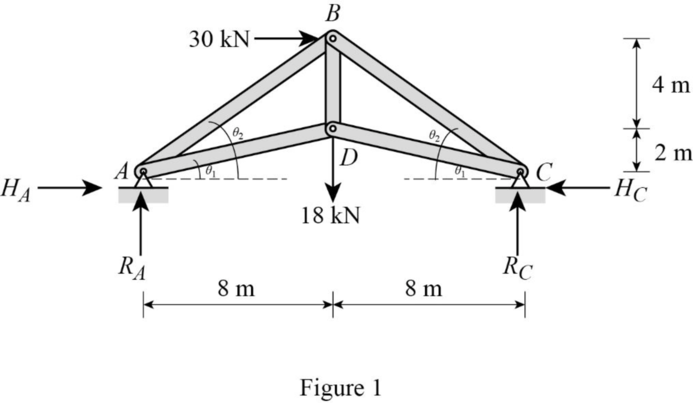
Find the reactions and all bar forces for the truss.
Explanation of Solution
Given information:
The Young’s modulus E of the beam is
The area (A) of all the bars is
Identify Zero Force Members:
In a two member forces, if both the members are not parallel and the no external loads or reactions acts at that joint. Then, the force in both the members is zero.
Calculation:
Show the free body diagram of the truss as shown in Figure 1.

Refer Figure 1.
Find the length of the member AB and BC as follows:
Consider triangle ABD.
By symmetry of truss,
Find the length of the member AD and DC as follows:
Consider triangle ADC.
By symmetry of truss,
Find the angle
Find the angle
Consider the horizontal reaction at C as the redundant.
Remove the redundant at C to get the released structure.
Show the released structure with applied load as shown in Figure 2.

Refer Figure 2.
Find the reactions at A, D, and C as follows:
Apply Equation of Equilibrium,
Find the forces
Refer Figure 2.
Consider Joint C.
Apply Equation of Equilibrium,
Consider joint B.
Apply Equation of Equilibrium,
Consider joint D.
Apply Equation of Equilibrium,
Show the P forces in the members of the truss due to the applied load at C as shown in Table 1.
| Members | |
| AB | |
| BC | |
| AD | |
| DC | |
| DB |
Table 1
Show the released structure loaded with unit horizontal load at C as shown in Figure 2.

Refer Figure 3.
By symmetry of the truss,
Consider Joint D.
Apply Equation of Equilibrium,
Solve Equation (1) and (2).
By symmetry of the truss,
Consider Joint B.
Apply Equation of Equilibrium,
Show the Q forces in the members of the truss due to the unit load at C as shown in Table 2.
| Members | |
| AB | |
| BC | |
| CD | |
| AC | |
| DB |
Table 2
Find the deflection
| Members | |||||
| AB | 10 | ||||
| BC | 10 | ||||
| AD | 8.246 | ||||
| DC | 8.246 | ||||
| DB | 4 |
Table 3
Refer Table 3.
Find the horizontal reaction at C as follows:
Thus, the horizontal reaction at C is
Find final forces in the truss as shown in Table 4.
| Members | ||||
| AB | -31.89 | 6.80 | ||
| BC | -31.89 | -30.7 | ||
| AD | -31.89 | -7.5 | ||
| DC | -31.89 | -7.5 | ||
| DB | -31.89 | 14.34 |
Table 4
Show the final support reaction as shown in Table 5.
| Support Reactions | ||||
| Members | ||||
| -30 | -1 | -31.89 | 1.89 | |
| -2.25 | 0 | -31.89 | -2.25 | |
| 20.25 | 1 | -31.89 | 20.25 | |
Table 5
Thus, the reactions and all bar forces for the truss is tabulate in table 4 and table 5.
Want to see more full solutions like this?
Chapter 9 Solutions
Fundamentals Of Structural Analysis:

 Structural Analysis (10th Edition)Civil EngineeringISBN:9780134610672Author:Russell C. HibbelerPublisher:PEARSON
Structural Analysis (10th Edition)Civil EngineeringISBN:9780134610672Author:Russell C. HibbelerPublisher:PEARSON Principles of Foundation Engineering (MindTap Cou...Civil EngineeringISBN:9781337705028Author:Braja M. Das, Nagaratnam SivakuganPublisher:Cengage Learning
Principles of Foundation Engineering (MindTap Cou...Civil EngineeringISBN:9781337705028Author:Braja M. Das, Nagaratnam SivakuganPublisher:Cengage Learning Fundamentals of Structural AnalysisCivil EngineeringISBN:9780073398006Author:Kenneth M. Leet Emeritus, Chia-Ming Uang, Joel LanningPublisher:McGraw-Hill Education
Fundamentals of Structural AnalysisCivil EngineeringISBN:9780073398006Author:Kenneth M. Leet Emeritus, Chia-Ming Uang, Joel LanningPublisher:McGraw-Hill Education
 Traffic and Highway EngineeringCivil EngineeringISBN:9781305156241Author:Garber, Nicholas J.Publisher:Cengage Learning
Traffic and Highway EngineeringCivil EngineeringISBN:9781305156241Author:Garber, Nicholas J.Publisher:Cengage Learning





